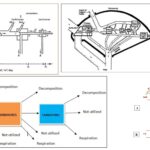Basic Microbiology 73 Views 1 Answers
Sourav PanLv 9September 4, 2024
What are the characteristic features of the hinge region of an antibody molecule? What are its functions?
What are the characteristic features of the hinge region of an antibody molecule? What are its functions?
Please login to save the post
Please login to submit an answer.
Sourav PanLv 9May 15, 2025
The hinge region of an antibody molecule is a crucial structural component that plays an essential role in the function of antibodies. Here are its characteristic features and functions:
Characteristic Features of the Hinge Region
- Location: The hinge region is situated between the Fab (Fragment antigen-binding) regions and the Fc (Fragment crystallizable) region of an antibody molecule. It is typically found in the IgG, IgA, and IgD isotypes but is less pronounced or absent in other isotypes like IgM and IgE.
- Structure:
- Flexibility: The hinge region is composed of a stretch of amino acids that provides flexibility to the antibody molecule. This flexibility is due to its relatively unstructured, flexible, and often rich in proline residues.
- Disulfide Bonds: It contains disulfide bonds that link the heavy chains of the antibody. These bonds help stabilize the overall structure of the antibody but allow for movement within the hinge region.
- Amino Acid Composition: The hinge region is rich in proline, which contributes to its flexibility, and it often contains other amino acids that enhance its structural properties.
Functions of the Hinge Region
- Flexibility:
- Antigen Binding: The flexibility provided by the hinge region allows the Fab regions to adopt different angles and conformations. This is important for the antibody’s ability to bind to antigens, especially when the antigens are spaced differently or have different spatial orientations.
- Adaptability: It enables the antibody to adapt to varying spatial arrangements of antigens, improving its ability to bind effectively to a wide range of targets.
- Binding to Antigen and Effectors:
- Fab Movement: The hinge region allows the two Fab arms of the antibody to move relative to each other. This movement is essential for the antibody to engage with multivalent antigens (antigens with multiple binding sites) and to form effective immune complexes.
- Fc Receptor Interaction: The hinge region helps position the Fc region optimally for interaction with Fc receptors on immune cells and complement proteins. This positioning is crucial for triggering effector functions such as antibody-dependent cellular cytotoxicity (ADCC) and complement activation.
- Linking of Heavy Chains:
- Stability and Conformation: The disulfide bonds in the hinge region connect the two heavy chains of the antibody, providing stability to the overall structure and ensuring the correct conformation for functional activity.
- Immunological Functions:
- Effector Function Modulation: The hinge region can influence the efficiency of immune responses by affecting how well the antibody engages with immune cells and other components of the immune system. For instance, a more flexible hinge region may enhance the binding of the antibody to Fc receptors on macrophages and other immune cells.
0
0 likes
- Share on Facebook
- Share on Twitter
- Share on LinkedIn
0 found this helpful out of 0 votes
Helpful: 0%
Helpful: 0%
Was this page helpful?




